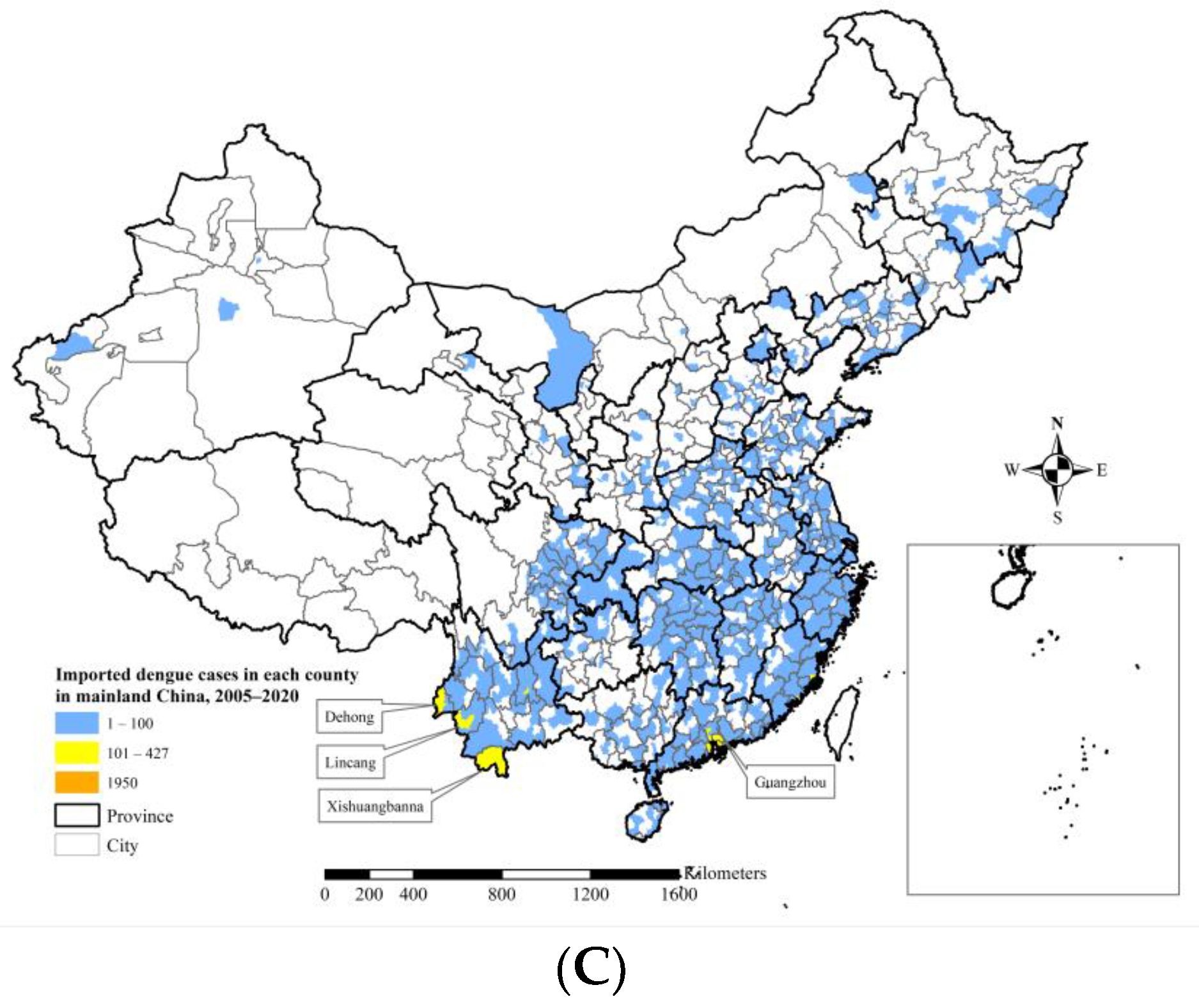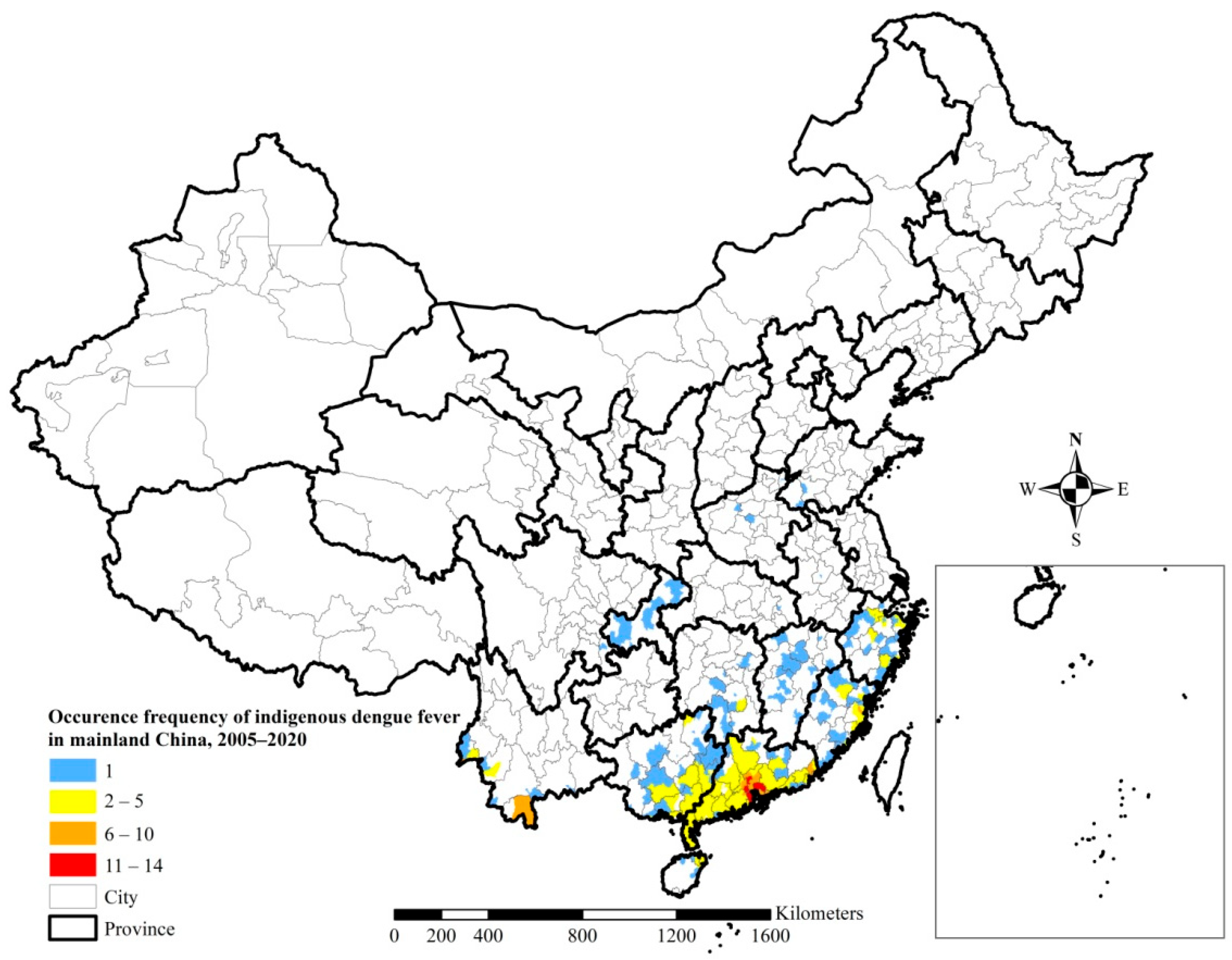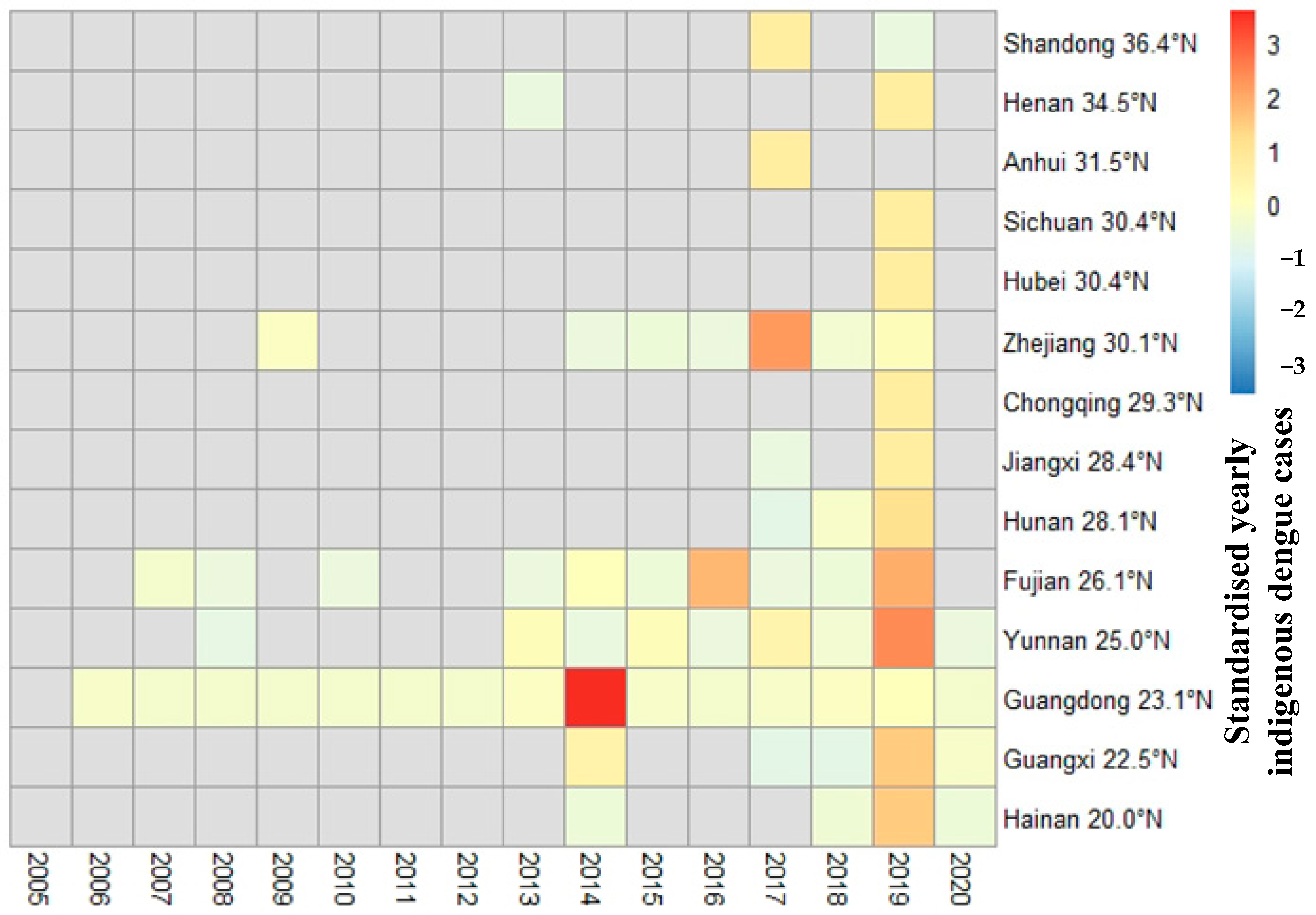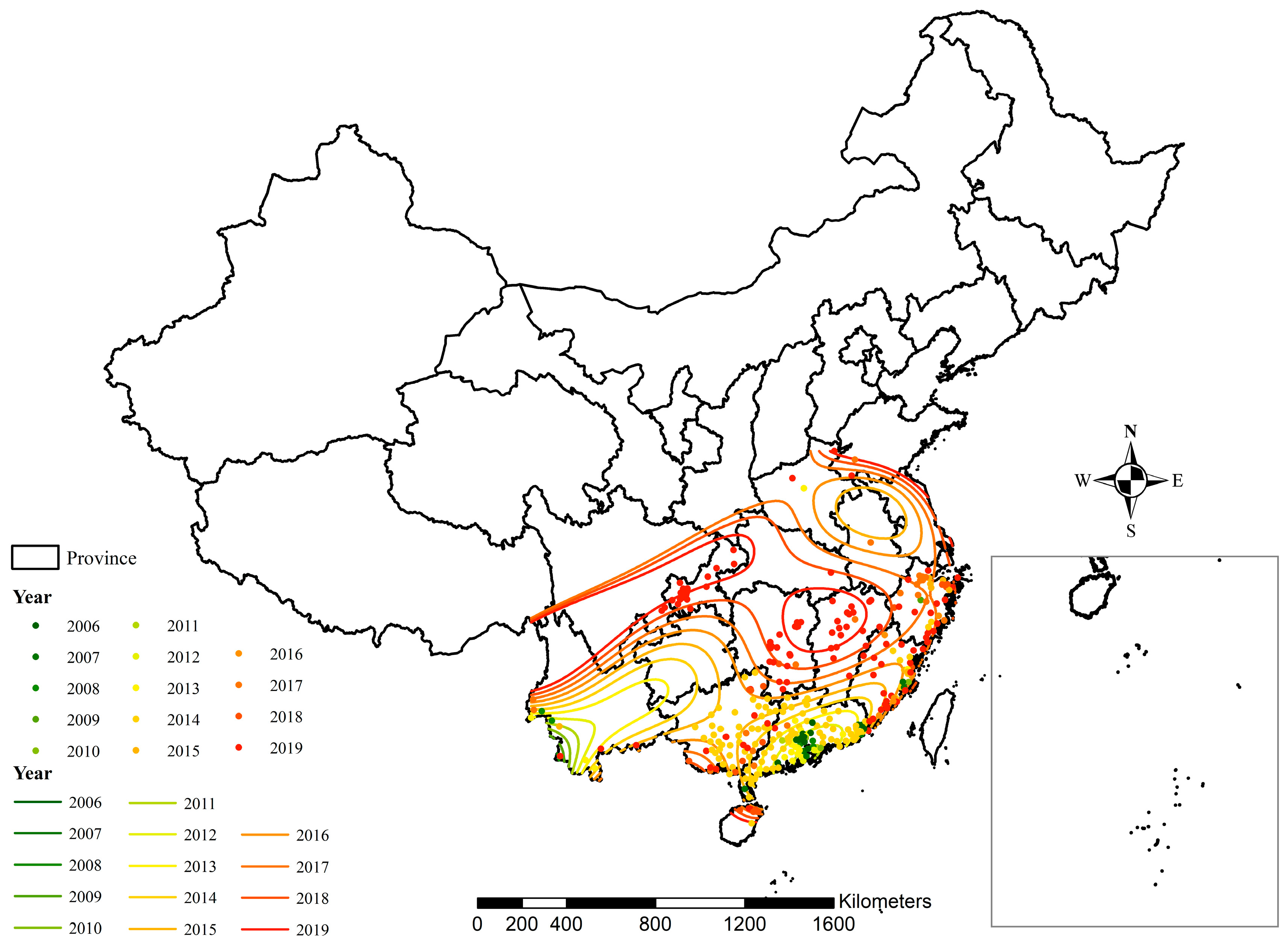Dengue Fever in Mainland China, 2005–2020: A Descriptive Analysis of Dengue Cases and Aedes Data
Abstract
:1. Introduction
2. Materials and Methods
2.1. Data Collection
2.2. Data Processing
2.3. Data Analysis
3. Results
3.1. Dengue Fever in Mainland China, 2005–2020
3.2. Indigenous Dengue Fever inMainland China, 2005–2020
3.2.1. Time-Series Analyses
3.2.2. Spatial Occurrence Frequency Analyses
3.2.3. Heat Map and Spatial Diffusion Analyses
3.3. Analyses of Aedes aegypti and Aedes albopictus in Mainland China
4. Discussion
5. Conclusions
Author Contributions
Funding
Institutional Review Board Statement
Informed Consent Statement
Data Availability Statement
Acknowledgments
Conflicts of Interest
References
- Fang, M.; Zhao, W.; Liu, J. Review of molecular epidemiology of dengue fever. Chin. J. Epidemiol. 2002, 23, 148–150. (In Chinese) [Google Scholar]
- Guzman, M.G.; Harris, E. Dengue. Lancet 2015, 385, 453–465. [Google Scholar] [CrossRef]
- Bhatt, S.; Gething, P.W.; Brady, O.J.; Messina, J.P.; Farlow, A.W.; Moyes, C.L.; Myers, M.F. The global distribution and burden of dengue. Nature 2013, 496, 504–507. [Google Scholar] [CrossRef] [PubMed]
- Zhao, Z.; Li, Z.; Wang, N. Prevalence of dengue fever and dengue hemorrhagic fever and control strategy in China. Hainan Prev. Med. 1997, 4, 1–4. (In Chinese) [Google Scholar]
- Du, J.-W.; Pan, X.-H. Prevalent status and features of dengue fever in China. Chin. J. Epidemiol. 2010, 31, 1429–1433. (In Chinese) [Google Scholar]
- Yue, Y.; Sun, J.; Liu, X.; Ren, D.; Liu, Q.; Xiao, X.; Lu, L. Spatial analysis of dengue fever and exploration of its environmental and socio-economic risk factors using ordinary least squares: A case study in five districts, Guangzhou City, China, 2014. Int. J. Infect. Dis. 2018, 75, 39–48. [Google Scholar] [CrossRef] [Green Version]
- Yue, Y.; Liu, X.; Ren, D.; Wu, H.; Liu, Q. Spatial dynamics of dengue fever in mainland China, 2019. Int. J. Environ. Res. Public Health 2021, 18, 2855. [Google Scholar] [CrossRef]
- Chen, B.; Liu, Q. Dengue fever in China. Lancet 2015, 385, 1621–1622. [Google Scholar] [CrossRef]
- Wu, J.; Lun, Z.; James, A.; Chen, X. Review: Dengue fever in mainland China. Am. J. Trop. Med. Hyg. 2010, 83, 664–671. [Google Scholar] [CrossRef] [Green Version]
- Sang, S.; Chen, B.; Wu, H.; Yang, Z.; Di, B.; Wang, L.; Tao, X.; Liu, X.; Liu, Q. Dengue is still an imported disease in China: A case study in Guangzhou. Infect. Genet. Evol. 2015, 32, 178–190. [Google Scholar] [CrossRef]
- Ministry of Health of the People’s Republic of China. Diagnostic Criteria and Principle of Management of Dengue (WS 216-2001); Standards Press of China: Beijing, China, 2001; pp. 1–12. (In Chinese) [Google Scholar]
- Ministry of Health of the People’s Republic of China. Diagnostic Criteria for Dengue (WS 216-2008); People’s Medical Publishing House: Beijing, China, 2008; pp. 1–17. (In Chinese) [Google Scholar]
- National Health and Family Planning Commission of the People’s Republic of China. Diagnosis for Dengue Fever (WS 216-2018); NHFPC: Beijing, China, 2018. Available online: http://www.nhc.gov.cn/ewebeditor/uploadfile/2018/03/20180330095421298.pdf (accessed on 1 May 2020). (In Chinese)
- Yue, Y.; Liu, Q.; Liu, X.; Wu, H.; Xu, M. Comparative analyses on epidemiological characteristics of dengue fever in Guangdong and Yunnan, China, 2004–2018. BMC Public Health 2021, 21, 1389. [Google Scholar] [CrossRef] [PubMed]
- Wu, Y.-C.; Qian, Q.; Magalhaes, R.J.S.; Han, Z.-H.; Hu, W.-B.; Haque, U.; Weppelmann, T.A.; Wang, Y.; Liu, Y.-X.; Li, X.-L.; et al. Spatiotemporal dynamics of scrub typhus transmission in mainland China, 2006–2014. PLoS Negl. Trop. Dis. 2016, 10, e0004875. [Google Scholar] [CrossRef] [PubMed] [Green Version]
- Qiu, F.-X.; Chen, Q.-Q.; Ho, Q.-Y.; Chen, W.Z.; Zhao, Z.-G.; Zhao, B.W. The first epidemic of dengue hemorrhagic fever in the People’s Republic of China. Am. J. Trop. Med. Hyg. 1991, 44, 364–370. [Google Scholar] [CrossRef] [PubMed]
- Luo, H.; He, J.; Zheng, K.; Li, L.; Jiang, L. Analysis on the epidemiologic features of Dengue fever in Guangdong province, 1990–2000. Chin. J. Epidemiol. 2002, 23, 427–430. [Google Scholar]
- Liang, W.; He, J.; Luo, H.; Zhou, H.; Zheng, K. Epidemiological analysis of dengue fever in Guangdong in 2001–2006. South Chin. J. Prev. Med. 2007, 33, 4–7. (In Chinese) [Google Scholar]
- Guo, R.-N.; Lin, J.-Y.; Li, L.-H.; Ke, C.-W.; He, J.-F.; Zhong, H.-J.; Zhou, H.-Q.; Peng, Z.-Q.; Yang, F.; Liang, W.-J. The prevalence and endemic nature of Dengue infections in Guangdong, South China: An epidemiological, serological, and etiological study from 2005–2011. PLoS ONE 2014, 9, e85596. [Google Scholar] [CrossRef]
- Zhang, F.-C.; Zhao, H.; Li, L.-H.; Jiang, T.; Hong, W.-X.; Wang, J.; Zhao, L.-Z.; Yang, H.-Q.; Ma, D.-H.; Bai, C.-H.; et al. Severe dengue outbreak in Yunnan, China, 2013. Int. J. Infect. Dis. 2014, 27, 4–6. [Google Scholar] [CrossRef] [Green Version]
- Sang, S.; Liu, Q.; Guo, X.; Wu, D.; Ke, C.; Liu-Helmersson, J.; Jiang, J.; Weng, Y.; Wang, Y. The epidemiological characteristics of dengue in high-risk areas of China, 2013–2016. PLoS Negl. Trop. Dis. 2021, 15, e0009970. [Google Scholar] [CrossRef]
- Liu, X.; Liu, K.; Yue, Y.; Wu, H.; Yang, S.; Guo, Y.; Ren, D.; Zhao, N.; Yang, J.; Liu, Q. Determination of factors affecting Dengue occurrence in representative areas of China: A principal component regression analysis. Front. Public Health 2021, 8, 603872. [Google Scholar] [CrossRef]
- Wang, C.; Chen, W. Prevalence of dengue fever in Hainan province in the history. J. Hainan Med. 1992, 3, 1–4. (In Chinese) [Google Scholar]
- Wu, F. A Study on the Potential Distribution of Aedes Albopictus and Risk Forecasting for Future Epidemics. Master’s Thesis, Chinese Center for Disease Control and Prevention, Beijing, China, 2009. [Google Scholar]
- Sun, J.; Lin, J.; Yan, J.; Fan, W.; Lu, L.; Lv, H.; Hou, J.; Ling, F.; Fu, T.; Chen, Z.; et al. Dengue virus serotype 3 subtype III, Zhejiang Province, China. Emerg. Infect. Dis. 2011, 17, 321–323. [Google Scholar] [CrossRef] [PubMed]
- Mu, D.; Cui, J.Z.; Yin, W.W.; Li, Y.; Chen, Q.L. Epidemiological characteristics of dengue fever outbreaks in China, 2015–2018. Chin. J. Epidemiol. 2020, 41, 685–689. [Google Scholar]
- Lai, S.J.; Huang, Z.J.; Zhou, H.; Anders, K.L.; Perkins, T.A.; Yin, W.; Qiu, Y. The changing epidemiology of dengue in China 1990–2014: A descriptive analysis of 25 years of nationwide surveillance data. BMC Med. 2015, 13, 100. [Google Scholar] [CrossRef] [PubMed] [Green Version]
- Sang, S.; Gu, S.; Bi, P.; Yang, W.; Yang, Z.; Xu, L.; Yang, J.; Liu, X.; Jiang, T.; Wu, H.; et al. Predicting unprecedented dengue outbreak using imported cases and climatic factors in Guangzhou, 2014. PLoS Negl. Trop. Dis. 2015, 9, e0003808. [Google Scholar] [CrossRef] [Green Version]
- Xu, L.; Stige, L.C.; Chan, K.-S.; Zhou, J.; Yang, J.; Sang, S.; Wang, M.; Yang, Z.; Yan, Z.; Jiang, T.; et al. Climate variation drives dengue dynamics. Proc. Natl. Acad. Sci. USA 2016, 114, 113–118. [Google Scholar] [CrossRef] [Green Version]
- Lippi, C.A.; Stewart-Ibarra, A.M.; Muñoz, Á.G.; Borbor-Cordova, M.J.; Mejía, R.; Rivero, K.; Castillo, K.; Cárdenas, W.B.; Ryan, S.J. The social and spatial ecology of dengue presence and burden during an outbreak in Guayaquil, Ecuador, 2012. Int. J. Environ. Res. Public Health 2018, 15, 827. [Google Scholar] [CrossRef] [Green Version]
- Li, R.; Xu, L.; Bjørnstad, O.N.; Liu, K.; Song, T.; Chen, A.; Xu, B.; Liu, Q.; Stenseth, N.C. Climate-driven variation in mosquito density predicts the spatiotemporal dynamics of dengue. Proc. Natl. Acad. Sci. USA 2019, 116, 3624–3629. [Google Scholar] [CrossRef] [Green Version]
- Xu, J.; Weekly, C.C. World pest day: Not for pests, but for people. China CDC Wkly. 2020, 2, 429–430. [Google Scholar] [CrossRef]
- Kan, B.; Chen, H. Prevalence of dengue fever in China and suggestions for surveillance research. Chin. J. Vector Biol. Control 1997, 8, 152–155. (In Chinese) [Google Scholar]
- Peng, W.; Yang, K.; Xu, W. Epidemiological investigation on an outbreak of dengue fever caused by an imported case. Mod. Prev. Med. 2007, 34, 2752–2753. (In Chinese) [Google Scholar]
- Cheong, Y.L.; Gruebner, O.; Krämer, A.; Lakes, T.; Cheong, Y.L. Spatio-temporal patterns of dengue in Malaysia: Combining address and sub-district level. Geospat. Health 2014, 9, 131. [Google Scholar] [CrossRef] [Green Version]
- Kurniawati, D. Rising Number of Dengue Fever Cases in Indonesia. 2013. Available online: http://www.aseantoday.com/2013/07/rising-number-of-den-gue-fever-cases-in-indonesia (accessed on 5 July 2015).
- Lefevre, A.S. Thailand Suffers Worst Dengue Epidemic in More than 20 Years. 2013. Available online: http://www.trust.org/item/20131024100249-aqxiv (accessed on 5 July 2015).
- Ng, L.-C.; Chem, Y.-K.; Koo, C.; Mudin, R.N.B.; Amin, F.M.; Lee, K.-S.; Kheong, C.C. 2013 dengue outbreaks in Singapore and Malaysia caused by different viral strains. Am. J. Trop. Med. Hyg. 2015, 92, 1150–1155. [Google Scholar] [CrossRef] [PubMed]
- Liu, Q.-Y. Challenge to vector control and sustainable vector management strategy. Chin. J. Epidemiol. 2012, 33, 1–6. [Google Scholar]
- Zhao, Z. Overview of dengue fever control in China. Chin. J. Epidemiol. 2000, 21, 223–224. (In Chinese) [Google Scholar]
- Xu, G.; Shi, N.; Dong, H.; Zhou, A.; Cheng, Z.; Chen, G.; Liu, J.; Fang, T.; Ye, J. Studies in the prevalent features of imported dengue fever and control meaures in Cixi, Zhejiang Province. Chin. Trop. Med. 2006, 6, 1129–1131. (In Chinese) [Google Scholar]







| Year | Dengue Cases | Counties with Dengue Fever | ||
|---|---|---|---|---|
| Indigenous | Imported | Indigenous | Imported | |
| 2005 | 0 | 45 | 0 | 33 |
| 2006 | 1007 | 46 | 15 | 33 |
| 2007 | 481 | 56 | 13 | 37 |
| 2008 | 86 | 134 | 11 | 62 |
| 2009 | 200 | 73 | 5 | 51 |
| 2010 | 112 | 119 | 14 | 64 |
| 2011 | 35 | 113 | 6 | 73 |
| 2012 | 438 | 149 | 14 | 86 |
| 2013 | 4263 | 460 | 36 | 182 |
| 2014 | 46,034 | 399 | 160 | 126 |
| 2015 | 3044 | 1083 | 44 | 264 |
| 2016 | 1549 | 675 | 41 | 211 |
| 2017 | 4609 | 2112 | 76 | 313 |
| 2018 | 3801 | 1266 | 100 | 457 |
| 2019 | 15,378 | 5813 | 266 | 1090 |
| 2020 | 616 | 158 | 7 | 101 |
| In all | 81,653 | 12,701 | 345 | 1400 |
Publisher’s Note: MDPI stays neutral with regard to jurisdictional claims in published maps and institutional affiliations. |
© 2022 by the authors. Licensee MDPI, Basel, Switzerland. This article is an open access article distributed under the terms and conditions of the Creative Commons Attribution (CC BY) license (https://creativecommons.org/licenses/by/4.0/).
Share and Cite
Yue, Y.; Liu, Q.; Liu, X.; Zhao, N.; Yin, W. Dengue Fever in Mainland China, 2005–2020: A Descriptive Analysis of Dengue Cases and Aedes Data. Int. J. Environ. Res. Public Health 2022, 19, 3910. https://doi.org/10.3390/ijerph19073910
Yue Y, Liu Q, Liu X, Zhao N, Yin W. Dengue Fever in Mainland China, 2005–2020: A Descriptive Analysis of Dengue Cases and Aedes Data. International Journal of Environmental Research and Public Health. 2022; 19(7):3910. https://doi.org/10.3390/ijerph19073910
Chicago/Turabian StyleYue, Yujuan, Qiyong Liu, Xiaobo Liu, Ning Zhao, and Wenwu Yin. 2022. "Dengue Fever in Mainland China, 2005–2020: A Descriptive Analysis of Dengue Cases and Aedes Data" International Journal of Environmental Research and Public Health 19, no. 7: 3910. https://doi.org/10.3390/ijerph19073910
APA StyleYue, Y., Liu, Q., Liu, X., Zhao, N., & Yin, W. (2022). Dengue Fever in Mainland China, 2005–2020: A Descriptive Analysis of Dengue Cases and Aedes Data. International Journal of Environmental Research and Public Health, 19(7), 3910. https://doi.org/10.3390/ijerph19073910






